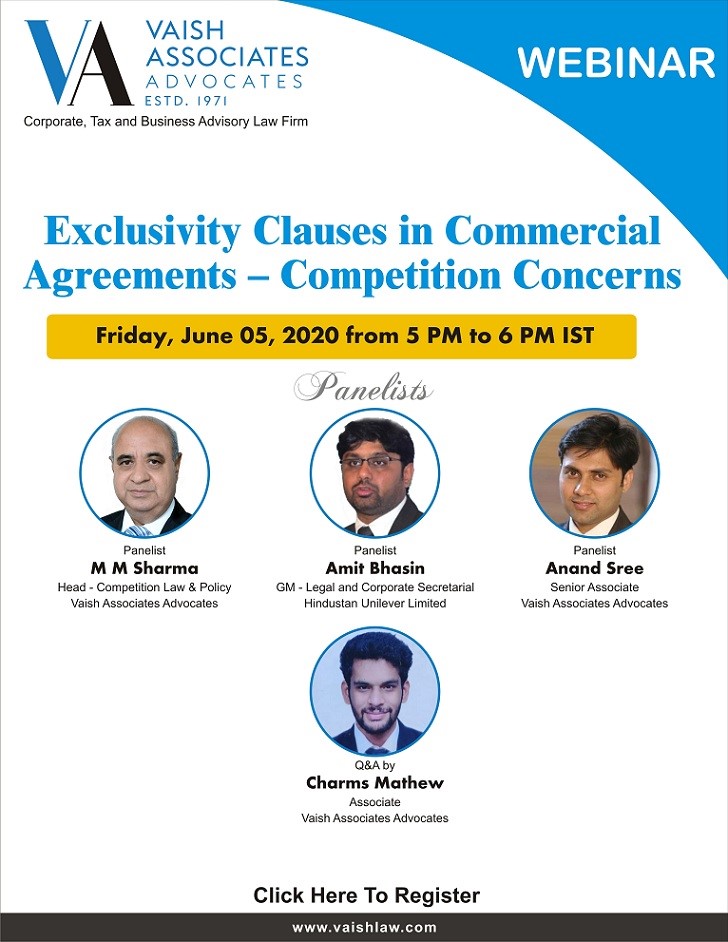India’s new competition regulator, the Competition Commission of India (CCI) is getting ready to commence regulation of “combinations” (acquisition, acquiring control, mergers and amalgamations between enterprises above the threshold limits mentioned in section 5 of the Competition Act, 2002) and has decided to publish the implementing draft regulations for merger control shortly.
Chairman, CCI has acknowledged that the period of 210 days provided in the Competition Act, 2002 (the Act) is rather long and there is need to include “pre-merger consultations” with the parties.
Without going into the validity of such proposed “consultations” within the existing statutory framework of the Act relating to regulation of combinations per-se, which must be concerning CCI, the idea must be welcome if it is intended to augment the existing competition advocacy efforts of CCI.
Perhaps, the provision of a ‘preliminary conference’ with the CCI before it makes an opinion on existence of a prima facie case, already existing in the General Regulations, can be amended to incorporate such pre-merger consultations.
In the above backdrop it is apt to understand the basic economics of a merger assessment from competition angle.
The term “merger” is used here in a broad sense and includes all ranges of corporate transactions such as acquisitions and acquiring of control, whereby a company acquires “the possibility of exercising decisive influence over the other” and is used as “combination” in the Act.
Merger assessment being ex-ante is a complicated process involving economic analysis at every stage and sufficient jurisprudence is available in the developed jurisdictions on the same.
In fact, before CCI is empowered to undertake the merger assessments under section 6 of the Act it would be worthwhile to augment its capacity by extensive training of the Members since serious concerns have been repeatedly raised by the leading Chambers of Business and Industries, such as Ficci, CII, Assocham on the efficacy of the largely bureaucratic CCI to appreciate complex economic issues.
The possibility that a merger will lead to the market being less competitive in the future then it currently is the main concern of competition law.
Since merger control is about predicting such possibility in future, it has to be theoretical and the competition regulator must have a “theory of competition harm” to intervene as to why market will be less competitive after the merger.
But the mere theory of harm is not sufficient as it would mean the regulatory intervention on mere speculation.
The competition regulator, therefore, must also produce evidence in support of its theory of harm by use of common empirical tests such as determination of correct relevant market, market shares and measure of pre-merger and post-merger concentration by using HHI, assessment of the closeness of competition between the merger parties through survey evidence, price concentration studies, impact analysis etc.
At the same, mitigating factors such as increase in “efficiency” as a result of the merger will also have to be kept in view in support of the proposed merger.
The efficiencies in a merger need not be restricted to only the price i.e. savings in marginal cost etc. but non- price efficiencies such as quality improvement, a new business model or R & D etc. are also to be considered.
Mergers typically are of three types. Horizontal mergers i.e. those between actual or potential competitor in the same product and geographic market and at the same level of production or distributor cycle. Horizontal mergers are the most likely to cause adverse effect on competition in the relevant market. Horizontal mergers produce both types of competitive harms i.e. unilateral as well as co-ordinated effects.
Vertical mergers are those between firms that operate at different, but complementary levels of the market for the same final product e.g. a merger between a car maker and a sheet metal manufacturer.
Often such mergers enhance efficiency in production and distribution but the possibility of harm on competition is there, either because it may leads to market power where by the merged entity may foreclose either the upstream or the down stream market to third parties or it could lead to collusion between the merged entity and third parties.
Conglomerate mergers i.e. mergers between enterprises dealing in different products all together such as merger between a car manufacturer and a textile firm.
Conglomerate mergers rarely raise competition concerns and in US such mergers have already been excluded from merger review guidelines. In the European Union (EU) however, the EC has expressed concern about the “portfolio” effect of such mergers.
The case of merger between GE and Honeywell is a case in point as the merger was allowed in US but was not permitted in EU.
Theories of competition harm – The most commonly used theories of competitive harm are (i) Unilateral effects (also called non-coordinated effects) and (ii) Co-ordinated effects.
Unilateral effects arise where the merged entity has the ability to profitably and unilaterally increase its prices, which require that it does not lose enough sales to make the price increase unprofitable.
The competitive constraints which currently exist between the parties is eliminated, which results in the merger creating an incentive for the merged entity to increase price.
The “lost” competition between the two merging parties gives rise to such an incentive to increase prices due to “internalization” of the “lost” sales. Such a merger may give rise to a “single firm dominance” because the ability of the merged entity to increase price does not depend upon a co-operative response from the remaining competitors.
This theory of harm presumes that the merger between two companies will lead to attainment of market power by the merged entity which then will have the ability to increase prices.
The term “price increase” includes all other manifestations of the exercise of market power such as reduction of output, lowering of quality, variety or innovation.
The unilateral effects are likely if, prior to the merger, an increase in price by one of the merging company would cause a substantial number of customers of the company to shift their purchases to the other merging company.
This is most likely to happen when both merging companies produce substitutable products e.g. a merger between a Cola Beverage Company with another brand of Cola Beverage Company.
Post merger the new merged entity would not lose any profits as a result of this shift since the merged entity would benefit from the increased sales of the other product.
The acquisition of, say, Thums up brand of Cola by Coca- Cola India is just the case in point as the increase in price of either brand would lead the customer to shift to the other brand which would ultimately benefit the acquirer Coca-Cola India.
In modern times, the larger enterprises do not change the name of “brand- product” of the acquired company and reap supra normal profits by increasing the prices of either of the brand products giving a false impression of increase the “inter-brand competition” with in the group which is generally considered as pro competitive.
Assessment of the possibility of unilateral effects on competition may not be difficult for CCI while examining such a proposed “merger” between two companies dealing in identical products which are interchangeable or substitutable from the demand side as the shift of consumer from one brand to other brand can easily be established by conducting sample surveys and using the empirical evidence to substantiate the theory of harm on competition.
Another aspect of unilateral effects theory of harm is that, after the merger between, say A & B in to the merged entity AB, C a competitor of AB will also be able to exercise market power because, if AB was to raise its prices, some customers would divert to C, which in turn could also raise its own prices. Thus, C may be able to increase prices and exercise market power thereby without “coordinating its behaviour with AB”. In this case C’s behaviour can itself be characterized as “unilateral” or “non-coordinated”. Therefore, unilateral effect may also become non-coordinated. This is also some times referred to as “second round effect”.







